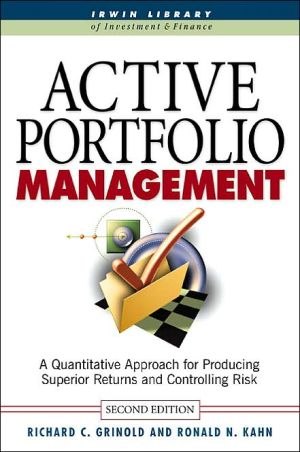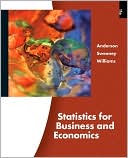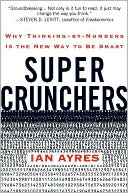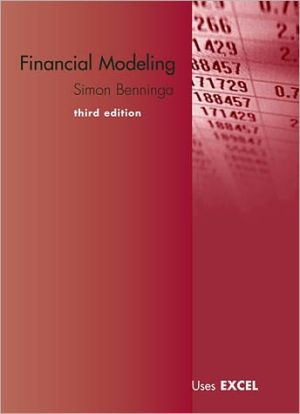Active Portfolio Management: A Quantitative Approach for Producing Superior Returns and Selecting Superior Returns and Controlling Risk
"This new edition of Active Portfolio Management continues the standard of excellence established in the first edition, with new and clear insights to help investment professionals."\ -William E. Jacques, Partner and Chief Investment Officer, Martingale Asset Management.\ "Active Portfolio Management offers investors an opportunity to better understand the balance between manager skill and portfolio risk. Both fundamental and quantitative investment managers will benefit from studying this...
Search in google:
An Innovative Approach to Portfolio Management. Blending the Most Profitable Aspects of Analytical and Quantitative.Professional acclaim for Active Portfolio Management, 2nd edition. "Active Portfolio Management is a unique reference for understanding the source of value-added by a money manager. I am an enthusiastic supporter of the methodology used in the book, and I highly recommend it to both the professional and academic communities."-Professor William N. Goetzmann, Director, International Center for Finance, Yale University School of Management."This edition of Active Portfolio Management continues the standard of excellence established in the first edition, with new and clear insights to help investment professionals."-William E. Jacques, Partner and Chief Investment Officer, Martingale Asset Management."Active Portfolio Management offers investors an opportunity to better understand the balance between manager skill and portfolio risk. Both fundamental and quantitative investment managers will benefit from studying this updated edition by Grinold and Kahn."-Scott Stewart, Portfolio Manager, Fidelity Select Equity ® Discipline, Co-Manager, Fidelity Freedom ® Funds."This second edition will not remain on the shelf, but will be continually referenced byboth novice and expert. There is a substantial expansion in both depth and breadth on the original. It clearly and concisely explains all aspects of the foundations and the latest thinking in active portfolio management."-Eric N. Remole, Managing Director, Head of Global Structured Equity, Credit Suisse Asset Management."Active Portfolio Management, Second Edition, remains a readable yet theoretically and mathematically rigorous book that one would expect from two such distinguished authors. I heartily recommend this book to any practitioner who wants to refine his or her knowledge of state-of-the-art quantitative money management or who would like a straightforward reference to quickly answer those thorny theoretical questions that hit us now and again."-Michael Even, Managing Director and Chief of Global Quantitative Analysis, Citibank Global Asset Management."A more comprehensive examination of quantitative techniques for portfolio management would be hard to find. Active Portfolio Management is an outstanding treatise on the methods and techniques of measuring performance and risk control that is both rigorous and understandable."-Jon A. Christopherson, Research Fellow, Frank Russell Company.Richard C. Grinold, Ph.D., is Managing Director, Advanced Strategies and Research at Barclays Global Investors. Dr. Grinold spent 14 years at BARRA, where he served as Director of Research, Executive Vice President, and President; and 20 years on the faculty at the School of Business Administration at the University of California, Berkeley, where he served as the chairman of the finance faculty, chairman of the management science faculty, and director of the Berkeley Program in Finance.Ronald N. Kahn, Ph.D., is Managing Director in the Advanced Active Strategies Group at Barclays Global Investors. Dr. Kahn spent 11 years at BARRA, including over seven years as Director of Research. He is on the editorial advisory board of the Journal of Portfolio Management and the Journal of Investment Consulting.Both authors have published extensively, and are widely known in the industry for their pioneering work on risk models, portfolio optimization, and trading analysis; equity, fixed income, and international investing; and quantitative approaches to active management.
Chapter 1: Introduction\ The art of investing is evolving into the science of investing. This evolution has been happening slowly and will continue for some time. The direction is clear; the pace varies. As new generations of increasingly scientific investment managers come to the task, they will rely more on analysis, process, and structure than on intuition, advice, and whim. This does not mean that heroic personal investment insights are a thing of the past. It means that managers will increasingly capture and apply those insights in a systematic fashion.\ We hope this book will go part of the way toward providing the analytical underpinnings for the new class of active investment managers. We are addressing a fresh topic. Quantitative active management-applying rigorous analysis and a rigorous process to try to beat the market-is a cousin of the modern study of financial economics. Financial economics is conducted with much vigor at leading universities, safe from any need to deliver investment returns. Indeed, from the perspective of the financial economist, active portfolio management appears to be a mundane consideration, if not an entirely dubious proposition. Modern financial economics, with its theories of market efficiency, inspired the move over the past decade away from active management (trying to beat the market) to passive management (trying to match the market).\ This academic view of active management is not monolithic, since the academic cult of market efficiency has split. One group now enthusiastically investigates possible market inefficiencies.\ Still, a hard core remains dedicated to the notion of efficient markets, although they have becomemore and more subtle in their defense of the market.\ Thus we can look to the academy for structure and insight, but not for solutions. We will take a pragmatic approach and develop a systematic approach to active management, assuming that this is a worthwhile goal. Worthwhile, but not easy. We remain aware of the great power of markets to keep participants in line. The first necessary ingredient for success in active management is a recognition of the challenge. On this issue, financial economists and quantitative researchers fall into three categories: those who think successful active management is impossible, those who think it is easy, and those who think it is difficult. The first group, however brilliant, is not up to the task. You cannot reach your destination if you don't believe it exists. The second group, those who don't know what they don't know, is actually dangerous. The third group has some perspective and humility. We aspire to belong to that third group, so we will work from that perspective. We will assume that the burden of proof rests on us to demonstrate why a particular strategy will succeed.\ We will also try to remember that this is an economic investigation. We are dealing with spotty data. We should expect our models to point us in the correct direction, but not with laserlike accuracy This reminds us of a paper called "Estimation for Dirty Data and Flawed Models."' We must accept this nonstationary world in which we can never repeat an experiment. We must accept that investing with real money is harder than paper investing, since we actually affect the transaction prices.\ Perspective\ We have written this book on two levels. We have aimed the material in the chapters at the MBA who has had a course in investments or the Practitioner with a year of experience. The technical appendices at the end of each chapter use mathematics to cover that chapter's insights in more detail. These are for the more technically inclined, and could even serve as a gateway to the subject for the mathematician, physicist, or engineer retraining for a career in investments. Beyond its use in teaching the subject to those beginning their careers, we hope the comprehensiveness of the book also makes it a valuable reference for veteran investment professionals.\ We have written this book from the perspective of the active manager of institutional assets: defined-benefit plans, defined-contribution plans, endowments, foundations, or mutual funds. Plan sponsors, consultants, broker-dealers, traders, and providers of data and analytics should also find much of interest in the book. Our examples mainly focus on equities, but the analysis applies as well to bonds, currencies, and other asset classes.\ Our goal is to provide a structured approach-a process-for active investment management. The process includes researching ideas (quantitative or not), forecasting exceptional returns, constructing and implementing portfolios, and observing and refining their performance. Beyond describing this process in considerable depth, we also hope to provide a set of strategic concepts and rules of thumb which broadly guide this process. These concepts and rules contain the intuition behind the process.\ As for background, the book borrows from several academic areas. First among these is modern financial economics, which provides the portfolio analysis model. Sharpe and Alexander's book Investments is an excellent introduction to the modern theory of investments. Modern Portfolio Theory, by Rudd and Clasing, describes the concepts of modern financial economics. The appendix of Richard Roll's 1977 paper "A Critique of the Asset Pricing Theory's Tests" provides an excellent introduction to portfolio analysis.\ We also borrow ideas from statistics, regression, and optimization. We like to believe that there are no books covering the same territory as this.\ Strategic Overview\ Quantitative active management is the poor relation of modern portfolio theory It has the power and structure of modern portfolio theory without the legitimacy Modern portfolio theory brought economics, quantitative methods, and the scientific perspective to the study of investments. Economics, with its powerful emphasis on equilibrium and efficiency, has little to say about successful active management. It is almost a premise of the theory that successful active management is not possible. Yet we will borrow some of the quantitative tools that economists brought to the investigation of investments for our attack on the difficult problem of active management.\ We will add something, too: separating the risk forecasting problem from the return forecasting problem. Here professionals are far ahead of academics. Professional services now provide standard and unbiased' estimates of investment risk. BARRA pioneered these services and has continued to set the standard in terms of innovation and quality in the United States and worldwide. We will review the fundamentals of risk forecasting, and rely heavily on the availability of portfolio risk forecasts.\ The modern portfolio theory taught in most MBA programs looks at total risk and total return. The institutional investor in the United States and to an increasing extent worldwide cares about active risk and active return. For that reason, we will concentrate on the more general problem of managing relative to a benchmark. This focus on active management arises for several reasons:\ \ Clients can clump the large number of investment advisers into recognizable categories. With the advisers thus pigeonholed, the client (or consultant) can restrict searches and peer comparisons to pigeons in the same hole.\ The benchmark acts as a set of instructions from the fund sponsor, as principal, to the investment manager, as agent. The benchmark defines the manager's investment neighborhood. Moves away from the benchmark carry substantial investment and business risk.\ Benchmarks allow the trustee or sponsor to manage the aggregate portfolio without complete knowledge of the holdings of each manager. The sponsor can manage a mix of benchmarks, keeping the "big picture."\ \ In fact, analyzing investments relative to a benchmark is more general than the standard total risk and return framework. By setting the benchmark to cash, we can recover the traditional framework.\ In line with this relative risk and return perspective, we will move from the economic and textbook notion of the market to the more operational notion of a benchmark. Much of the apparatus of portfolio analysis is still relevant. In particular, we retain the ability to determine the expected returns that make the benchmark portfolio (or any other portfolio) efficient. This extremely valuable insight links the notion of a mean/variance efficient portfolio to a list of expected returns on the assets.\ Throughout the book, we will relate portfolios to return forecasts or asset characteristics. The technical appendixes will show explicitly how every asset characteristic corresponds to a particular portfolio. This perspective provides a novel way to bring heterogeneous characteristics to a common ground (portfolios) and use portfolio theory to study them.\ Our relative perspective will focus us on the residual component of return: the return that is uncorrelated with the benchmark return. The information ratio is the ratio of the expected annual residual return to the annual volatility of the residual return. The information ratio defines the opportunities available to the active manager. The larger the information ratio, the greater the possibility for active management.\ Choosing investment opportunities depends on preferences. In active management, the preferences point toward high residual return and low residual risk. We capture this in a mean/variance style through residual return minus a (quadratic) penalty on residual risk (a linear penalty on residual variance). We interpret this as "risk-adjusted expected return" or "value-added." We can describe the preferences in terms of indifference curves. We are indifferent between combinations of expected residual return and residual risk which achieve the same value-added. Each indifference curve will include, a "certainty equivalent" residual return with zero residual risk....
PrefaceAcknowledgmentsCh. 1Introduction1Pt. 1FoundationsCh. 2Consensus Expected Returns: The Capital Asset Pricing Model11Ch. 3Risk41Ch. 4Exceptional Return, Benchmarks, and Value Added87Ch. 5Residual Risk and Return: The Information Ratio109Ch. 6The Fundamental Law of Active Management147Pt. 2Expected Returns and ValuationCh. 7Expected Returns and the Arbitrage Pricing Theory173Ch. 8Valuation in Theory199Ch. 9Valuation in Practice225Pt. 3Information ProcessingCh. 10Forecasting Basics261Ch. 11Advanced Forecasting295Ch. 12Information Analysis315Ch. 13The Information Horizon347Pt. 4ImplementationCh. 14Portfolio Construction377Ch. 15Long/Short Investing419Ch. 16Transactions Costs, Turnover, and Trading445Ch. 17Performance Analysis477Ch. 18Asset Allocation517Ch. 19Benchmark Timing541Ch. 20The Historical Record for Active Management559Ch. 21Open Questions573Ch. 22Summary577App. A: Standard Notation581App. B: Glossary583App. CReturn and Statistics Basics587Index591








